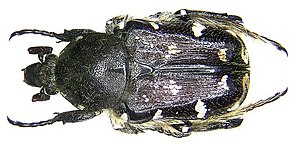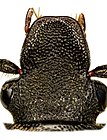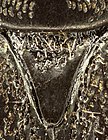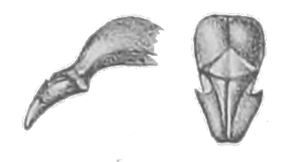Heterocnemis graeca
| Heterocnemis graeca | ||||||||||||
|---|---|---|---|---|---|---|---|---|---|---|---|---|

Heterocnemis graeca ♂ |
||||||||||||
| Systematics | ||||||||||||
|
||||||||||||
| Scientific name | ||||||||||||
| Heterocnemis graeca | ||||||||||||
| ( Brullé , 1832) |
Heterocnemis graeca is a beetle from the family of the rose chafer , in the subfamily Cetoniinae is provided. The genus Heterocnemis occurs in only one species in Europe, another species is known from Iran.

|
||
| Fig. 1: Top view ♀, photo Udo Schmidt | ||

|

|

|
|
Fig. 2 left: top view of the head, head shield almost not cut out; Middle: left front rail ♀ with three outer teeth; right: label, tip rounded |
||

|
||
| Fig. 3: Aedeagus, left side | ||
Notes on names and synonyms
The beetle was first described as Cetonia graeca by the French Brullé in 1832 . The species name graeca ( Latin for Greek) is explained by the fact that Brullé, as a scientific companion of the Morea expedition, found the beetle in Greece on the Peloponnese .
The beetle was later assigned to the genera Leucocelis and Oxythyrea at times . In 1852 Albers created a new genus Heterocnemis for him . The name Heterocnemis is from Altgr. έτερος “héteros” for “different” and κνημίς “knemis” for the rail and refers to the fact that the front and rear rails are different in males and females.
Description of the beetle
The beetle is about one and a half centimeters long (11.5-16 millimeters) with a width of eight millimeters. It is somewhat similar to the rose beetles Oxythyrea funesta and Tropinota hirta , which are widespread in Europe , because all three are about the same size and dark with white spots. Viewed from above, however, Heterocnema graeca differs from the other two in that it has a less pointed label (Fig. 2 right) and a head shield that is barely outlined at the front (Fig. 2 left). It also differs from the genus Oxythyrea in that it is more compactly built and on the pronotum it is at most dotted with white. It differs from Tropinota in that its pronotum does not have a smooth, flat keel like this one.
The basic color of the beetle is black, the wing covers are black-brown. The head shield (Fig. 2 left) covers the upper jaw. The head shield is slightly longer than it is wide, with a flat edge in the front area and only very slightly concave at the tip . The head shield is cut above the sensor so that the deflection points of the sensor are visible from above. The antennae are nine-part. The last three links are freely movable and extended on one side to a three-leaved antenna lobe. The antennae is one and a half times as long in the male as in the female. The jaw buttons and lip buttons are blackish. The maxillary probes end with an unusually long cylindrical end link. The head is dotted with wrinkles. In the males it is - like the rest of the body - significantly more hairy than in the females. The hair is short and whitish-yellowish.
The pronotum is about the same length as it is wide, flattened, cut off almost straight in front, and as wide as the head. Then it widens evenly towards the back up to the middle, after which it narrows only slightly up to the rounded rear angles. The base of the pronotum is slightly convex throughout, not concave in front of the shield. In undamaged animals, the pronotum is also covered with a short yellowish fluff. It's edged on the side. At the corner where the widening of the pronotum merges into a parallel course, there may be a white spot. There may also be a white spot in the back corners. Puncturing the pronotum is similar to puncturing the head. A wedge-shaped area is not punctured in front of the label.
The label is elongated triangular, but rounded at the tip. It is strongly dotted at the base, and sparsely hairy yellow, smooth at the tip (Fig. 2 right). Laterally it is not deeply furrowed like in Tropinota . Like the wing covers, the label is very dark brown in color.
The elytra are wider than the pronotum, the front corners protruding and rounded. Towards the end, the wing corners become a little narrower and they end abruptly, only the end of the wing cover seam protrudes a little. At the front the wing covers are cut out flat on the sides, which enables flight when the wing covers are closed. Between the pronotum and the wing coverts, the skeletal parts (epimers of the mid-breast) lying above the mid-breast are clearly visible from above (Fig. 1). The puncture of the wing covers is dense except for the shoulder bumps and consists mainly of comma-shaped punctures. Irregular groove-shaped strips are formed on the disk. The hair is much less dense than on the head and breastplate. It is short and yellowish. The wing covers have about eight symmetrically arranged white toment spots . Most noticeable is the laterally lying spot at the widest point of the wing-coverts behind the cutout and the slightly smaller four spots, which roughly form a rectangle and lie on the disk in front of and behind the first-mentioned spots.
There are also usually white spots on the epimers between the base of the wing cover and the pronotum and on the legs.
According to Albers, the front splints in the male are sharp, two-toothed, in the female they are bluntly three-toothed . In various identification tables, however, the beetle is listed with the property 'two teeth on the front rails'. Also from Fig. 2 middle it can be seen that in females the third tooth is partially only indicated. The middle and rear rails end with jagged edges (fingered). The middle rails carry two movable end mandrels that are directly next to each other. According to Albers, the rear rails in the females end with two end spines, in the males only with one end spike. This difference in particular is the reason for the generic name. In more recent identification codes, this difference is usually only put into perspective by the wording with an end pin . The tarsi are all five-limbed and longer than the splints, the hind tarsi in the males thicker than in the females, the first limb curved upwards and inward, from the third limb laterally compressed and covered with a thick lash line on the top. The legs and the underside are densely lightly haired.
The pygidium also has two white spots.
The aedeagus (Fig. 3) is distinguished from other rose beetles by the peculiar curvature of the basal part (see side view).
biology
The sparse find data suggest that the beetle can be found between May and July. In the first description it is specified as a biotope on sweet grasses .
In an investigation of different species of donkey thistle as host plants of insects, the adult beetle was only found feeding on the outside of Onopordum bracteatum . It was noted, however, that it was also found on other composites . Exceptionally, however, the beetle is also reported as frequent on flowering trees . Without a source, you can find information on the Internet that the larva develops in decayed wood of deciduous trees.
distribution
The beetle is only found in Greece , Crete , the Cyclades and western Asia Minor .
Individual evidence
- ↑ Heterocnemis graeca at Fauna Europaea, accessed on April 22, 2018 [1]
- ↑ a b Heterocnemis at Coleo-net, accessed on April 22, 2018
- ↑ a b G. Kraatz: About the male copulate of the European Cetoniden and its usability for their sharp specific differentiation . In Deutsche Entomologische Zeitschrift (previously Berliner Entomologische Zeitschrift) 25th year Berlin 1881 p. 113 ff. Figure panel 1 Fig. 2 Description
- ↑ a b c d M. Brullé: Expédition scientifique de Morée Tome 3, Zoologie, 2nd Section Paris 1832 p. 183, No. 326 in the Google book search
- ^ A b G. Albers: Heterocnemis, a new genus of melitophiles . In Entomological Journal - published by the Entomological Association in Stettin 13th year, Stettin 1852 p. 46
- ↑ Notes sur quelques espèces d'Oxythyrea without mentioning the author, with a footnote from G. Kraatz: The short notes given to me by a French colleague are intended to encourage further study of the difficult Oxythyrea species . In Entomological Monthly Sheets II No. 14, April 1880 p. 63
- ↑ a b Jaques Baraud: Faune de France, Coléoptères Scarabaeoidea d'Europe Paris 1992 797
- ↑ Find data for cetonids
- Jump up ↑ DT Briese, AW Sheppard, H. Zwölfer, PE Boldt: Structure of the phytophagous insect fauna of Onopordum thistles in the Northern Mediterranean basin . In Biological Journal of the Linnean Society (1994) , 53, 231-253 p. 252
- ↑ Roger Dajoz: Note sur quelques Cétoines de Grece . In L'Entomologiste Tome XXXI, No. 2 1975 [2]
- ↑ Portrait of the beetle